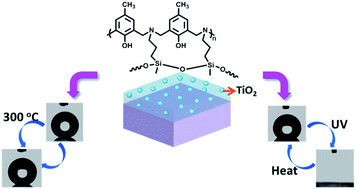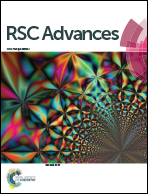Fluorine-free superhydrophobic/hydrophobic polybenzoxazine/TiO2 films with excellent thermal stability and reversible wettability†
Abstract
Two important properties are combined: the low surface free energy property of polybenzoxazine (PBZ) and the photo-induced superhydrophilicity property of TiO2. A benzoxazine monomer, synthesized by a one-step method, is incorporated with TiO2. Polybenzoxazine/titanium dioxide (PBZ/TiO2) nanocomposite films are prepared using spin coating and a thermal curing method. As a result, a superhydrophobic PBZ/TiO2 film with the largest water contact angle (CA) of ∼166 ± 1° is developed by incorporating a low content of TiO2 (11 wt%, relative to the weight of the benzoxazine monomer) into a PBZ system without any fluorine-containing surface modification agents. The as-prepared superhydrophobic film has good adhesion to glass substrates, and its superhydrophobicity is stable even after heat treatment at 300 °C for 1 h and environmentally durable for more than half a year. When the content of TiO2 is increased to 60%, the consequent nanocomposite film exhibits hydrophobicity–superhydrophilicity transitions with a variation of around 125° in water CA upon ultraviolet (UV) exposure–heat treatment cycles. The effects of the content of TiO2 on the surface wettability, morphology and reversibly switchable wettability of the PBZ/TiO2 films are investigated in detail.


 Please wait while we load your content...
Please wait while we load your content...